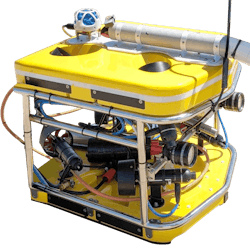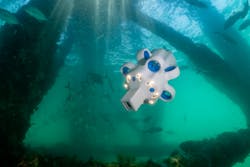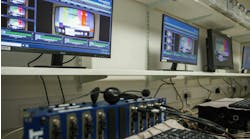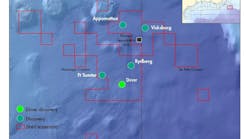Editor's note: This Subsea Systems column first appeared in the May-June 2023 issue of Offshore magazine. Click here to view the full issue.
By Ariana Hurtado, Editor and Director of Special Reports
Last year was a busy one for Advanced Navigation as it released two new technologies: the Boreas D70 fiber-optic gyroscope inertial navigation system and the Hydrus fully autonomous subsea drone.
The company specializes in AI-based navigation and robotics that service multiple industries, including the marine and subsea sectors.
Discussing current subsea systems challenges, Peter Baker, senior product manager with Advanced Navigation, told Offshore that a common challenge the company's customers face is when depths and other conditions are not favorable.
"Subsea pipeline inspection is critical to the safe transfer of oil and gas from offshore rigs to storage and processing facilities on land. Typically, large and heavy work-class ROVs are used for this purpose; however, these ROVs remain suited to large-scale operations and at suitable depth," he explained. "For example, as the water becomes shallower or the environment more sensitive to larger vessels, complications arise in getting appropriately sized and maneuverable equipment into place. The situation might entail using divers or perhaps not surveying at all."
As a result, he said more companies are moving toward small-scale ROVs to reduce overall costs, carbon emissions, vessel and crew sizes. "However, this brings the challenge of sourcing a subsea navigation system that is appropriately sized, easy to install, and doesn’t affect performance or maneuverability," he added.
Advanced Navigation has developed Subsonus USBL2, a miniature underwater acoustic positioning system that is designed to provide high-accuracy position, velocity and heading at ranges of up to 1,000 m. The system features a calibrated hydrophone array combined with an internal tightly coupled inertial navigation system, all packed into a miniature titanium enclosure small enough to fit in the palm of your hand, Baker said. It runs fully on the processor within the transceiver and is accessible via a web browser, with no additional rack-mounted interface units or processing PCs.
Case study
Scandinavia-based JM Robotics, a supplier of small, robust ROV systems, was tasked with carrying out a submarine pipeline inspection for a major energy provider. The challenge was developing an agile, miniature ROV that provided accurate acoustic heading and absolute position in difficult shallow-water conditions.
"For JM Robotics, the first challenge was to design an ROV that could operate in shallow depths and be deployed by two crew members, while the ROV was meant to reduce carbon emissions, expenditure, vessel and crew sizes," Baker explained. "The maximum ROV weight was capped at ~50 kg (in air). The requirement for lightness immediately discounted a range of components that are either too big and/or heavy or would otherwise compromise manoeuvrability of the ROV."
Johan Hellstrøm, JM Robotics technical manager, summed up the challenges, stating, "This was more challenging than we expected because of poor or no visibility, a lot of current, shallow water with obstacles such as fishing nets. The pipes are magnetic also. There were also disturbances due to boat engines and water jets that needed to be handled without disrupting the USBL or sensors. There were a lot of very difficult situations.”
The small size of the JM Robotics HD3 ROV necessitated using an ultra-compact USBL2 system that would not impede maneuverability or affect buoyancy of the vehicle.
"In this case, Advanced Navigation’s Subsonus was found to be the only viable solution that had the necessarily small physical dimensions and minimal weight for the project," Baker said. "Complementing this, the straightforward installation and connectivity of the Subsonus made the system easy for the team to set up, test and verify for both ROV and surface vessel."
As a result, the company received accurate ROV navigation using acoustic heading. The Acoustic Compass heading provided by Subsonus in USBL2 configuration meant that the ROV project is commercially viable.
"JM Robotics found that using Subsonus immediately provided the additional navigation functions and accuracy that they required," he continued. "This particular application requires complex ROV piloting, using six-degrees of freedom of movement, to follow the hidden pipelines and successfully battle currents and avoid various obstacles. This makes ROV heading even more essential to the solution.
"ROV piloting is also improved when visibility becomes difficult, with Subsonus providing continuous position and acoustic heading data regardless of water turbidity. An added benefit is that having accurate ROV position and heading can provide additional safeguards against collisions which, particularly in resource extraction applications, can be devastating to the environment."
New subsea robotics center
Being based in Australia, Baker explained how subsea technologies might differ there versus other offshore regions.
"Operating in tropical water comes with its own issues," he said. "Traditionally, offshore technology is developed in the North Sea, where conditions vary to Australia. The tropical waters of Australia are very conducive to biofouling and marine growth, and the warmer waters also drastically change the heat-sinking ability of subsea technology."
In April Advanced Navigation announced it is developing a subsea robotics R&D and manufacturing complex in Balcatta, Western Australia. The company expects the facility to help it meet growing demand for underwater data, bringing its existing and new technologies to market more quickly, with further plans to triple the size of its subsea team.
The subsea center is located on a 5.5-acre site designed for high-volume production, research and expansion of subsea navigation and robotics technologies, including the company’s underwater AI division. Its innovations to date include "extreme miniaturization" of pressure-tolerant electronics, sonar technologies and AI-based autonomous systems. Also on site will be test facilities with various marine simulation environments. The company has support from research institutions such as the University of Western Australia and Curtin University.
Baker said Advanced Navigation is working on a number of navigational and robotic technologies and that this high-tech manufacturing and R&D facility will accelerate the production of the company's underwater technologies, including its Hydrus autonomous underwater robot. Hydrus can map and survey subsea structures, and it is designed for subsea research, survey and exploration, employing navigational, sonar, propulsion and data capture technologies with artificial neural network intelligence.
"Our autonomous underwater vehicle, Hydrus, is a great example of stretching the boundaries of what’s possible," he continued. "Using in-house design and vertical integration manufacturing techniques, Hydrus has maximized subsystem AI harmonization to enable high levels of miniaturization. This makes the overall package efficient, portable, fully autonomous and enables Hydrus to move like no other underwater vehicle."
The path forward
Baker shared his perspectives on the current subsea market and the path forward. "The subsea industry is rapidly moving toward remote offshore operations and seeking overall reductions in costs, vessels, fuel time and carbon footprint," he said. "As a result, maritime companies should look to evaluate their current systems and procedures to see where innovations in technology can support."
He added that subsea users need tools that will provide both commercial benefits and will assist in improving human interaction with underwater environments.
"Moving forward, the sector should leverage expertise in precision robotics, navigation and artificial intelligence to create new horizons that will mutually benefit human effort and sustainable interaction with marine habitats and lifeforms," Baker concluded.






